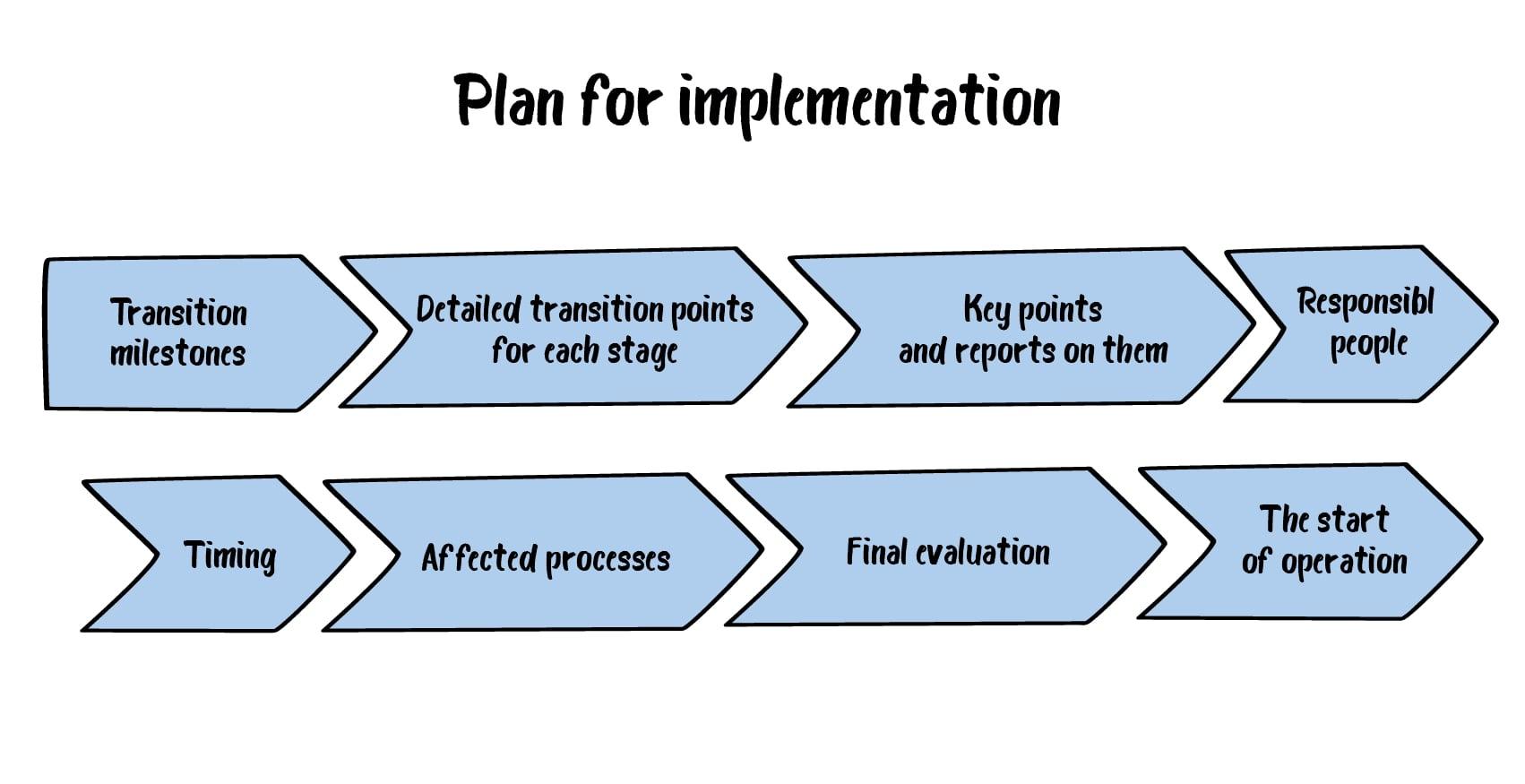

This article can help you answer questions on enhancing your company’s operations and customer experience by implementing new software. Read up-to-date information about three key strategies. Get a free consultation from our experts to manage change and unlock benefits through the long-term implementation of software.
Reading time: 20 min.
If you have the developed software for your company, you are halfway to success. The business should have a step-by-step implementation plan to get long-term value and recover the costs of implementing a new system in the workplace.
This article will disclose three strategies and practical tips on how to implement new tools in a company, ensuring a seamless transition and efficient decision-making process to achieve team-specific goals in the early stages.
Let’s start with the most common reasons why businesses may need new technology adoption.
Сonsidering other information can support the decision-making process for larger and smaller businesses. There are at least four reasons to adopt new software in a company and enhance team efficiency:
Of course, the first 2 cases require more effort and could cause some issues without a successful software implementation plan in day-to-day processes. And here, we proceed to the best practice strategies for a company’s new software implementation process, even if you intend to migrate to a new Content Management System.
Remember, it is crucial to follow best practice strategies that include careful planning, effective communication, and utilizing built-in project templates and other tools for the entire company’s new software system implementation process. That’s why you have to avoid making bad strategic decisions.
The selection process is a time-consuming, daunting task and a serious undertaking. Let’s move on to the three core strategies for switching and adapting to new software with the most value.
Adopting the Big Bang method is the most rigid transition when you set the exact date and manually migrate, turning off the old software application by 100%. The Big Bang’s successful implementation is the “all at once” strategy, which requires a lot of pre-launch planning, staff training programs, and organizational tuning. You can influence training.
Pros
All possible changes are done simultaneously and are noticeable almost immediately; there is no need to detect and isolate the particular factors that influence productivity, application development at full speed, and sales, which leads to an increased ROI.
Cons
The Parallel strategy of a new software implementation is a more soft and versatile way of transition. This approach allows decision-makers to set a time when both systems will function simultaneously to compare results and output. This approach delivers full benefits for the project owner.
Pros
Cons
Phased software adoption is the softest approach to implementing new software. The transition can be done functionally, by divisions, and in the agreed timeframes. This strategy implies gradually replacing the old system, starting with the core functionality implementation and then additional modules and functionality rollout. Phased Adoption is the safest way to implement new technology by a software implementation team, though it also has particular drawbacks for businesses.
Pros
Cons
Big Bang, Parallel Running, and Phased Adoption strategies are good ones. But which one suits your clear goals?
In most cases selecting the most suitable software vendor in organizational efficiency and performance as a key stakeholder in your implementation plan is crucial. Identify the challenges your company encounters and areas that require improvement by engaging in open conversations with your staff and other relevant stakeholders.
You can ask several questions. Does the software integrate with your company’s existing systems? Is the software scalable? Does the vendor provide a software training program? What are the best practices for implementing new software? Which of them cost inclusive of post-sales support? Are there hidden costs? Do the updates and upgrades delivered operate on a cloud-based platform? Additionally, considering the readiness and involvement of the entire organization in the implementation process is essential for successful software investment.
There are some core factors affecting what new software implementation approach the business should choose:

To maximize the benefits of implementing a new system, businesses should have a comprehensive implementation plan that aligns with the software development life cycle. This plan outlines the step-by-step process, including tasks, timelines, and responsibilities. It addresses infrastructure assessment, data migration, user training, system integration, and testing.
When implementing new software, striving for utmost specificity in defining your goals is crucial, aiming to achieve the best strong business case scenario. Rather than making general statements like “eliminating the backlog of work orders,” challenge your organization to set a more precise objective, such as “reducing the average backlog of work orders by 50% within six months.” By being specific, you provide a clear picture of the desired outcomes, ensuring clarity and focusing on improved visibility and achieving tangible results.
Research shows that the critical step to look out for is the employees affected by implementing the new software. We are now considering a 100% human factor, so analysis of employees’ impact cannot be avoided. Neglecting this aspect can lead to employee dissatisfaction and hinder the overall success of the implementation.
What should you pay attention to when implementing new tools, and the last thing to consider is:
You may have some of the above, but it is crucial to have a plan in place. It is important to comprehend the risks involved and designate a point person responsible for overseeing the implementation process. A clear plan of action is essential to avoid repeating the same mistakes made by other companies and ensure a successful software implementation. Moreover, the plan should be updatable, clear, inevitable, accessible for discussion, and transparent for all stakeholders, implementation teams, and system champions. You also have to assign a change manager.
Aligning the plan with the requirements of on-premise employees, who will serve as the end-users of the new tool, is essential to ensure that each employee is well-informed about the specific features they can utilize. Embracing flexibility and buy-in during the transition or implementation plan is a prevailing norm that fosters a sense of ownership and engagement among employees. It is important to acknowledge that both unexpected challenges and expected issues may arise during the implementation process. Therefore, leaving room for refining the plan and adjusting its attributes based on feedback and evolving needs becomes crucial for achieving successful implementation and learning from the success stories of other organizations.

What should be in the plan:
Remember that the composition of your implementation team reflects your dedication to the initiative’s success. Hence, select staff who possess exceptional skills and excellent teamwork abilities.
Implementing a new software system by the project team is not a one-day revolution but a gradual process. In a flawed implementation process, the consequences can lead to experience operational downtime, resulting in lost revenue. Exploring the software market’s options can aid in selecting a system that aligns with the organization’s requirements and enhances user experience.
To ensure a successful implementation, the core aspect of prioritizing is the employees, who will ultimately use the new system as end-users.
If you are currently facing pain points and looking to develop a software product to enhance your project’s success, contact us for a free consultation and get your software developed from scratch!
Implementing a new software system by the project team is not a one-day revolution but a gradual process. In a flawed implementation process, the consequences can lead to experience operational downtime, resulting in lost revenue. Exploring the software market’s options can aid in selecting a system that aligns with the organization’s requirements and enhances user experience.
To ensure a successful implementation, the core aspect of prioritizing is the employees, who will ultimately use the new system as end-users.
If you are currently facing pain points and looking to develop a software product to enhance your project’s success, contact us for a free consultation and get your software developed from scratch!